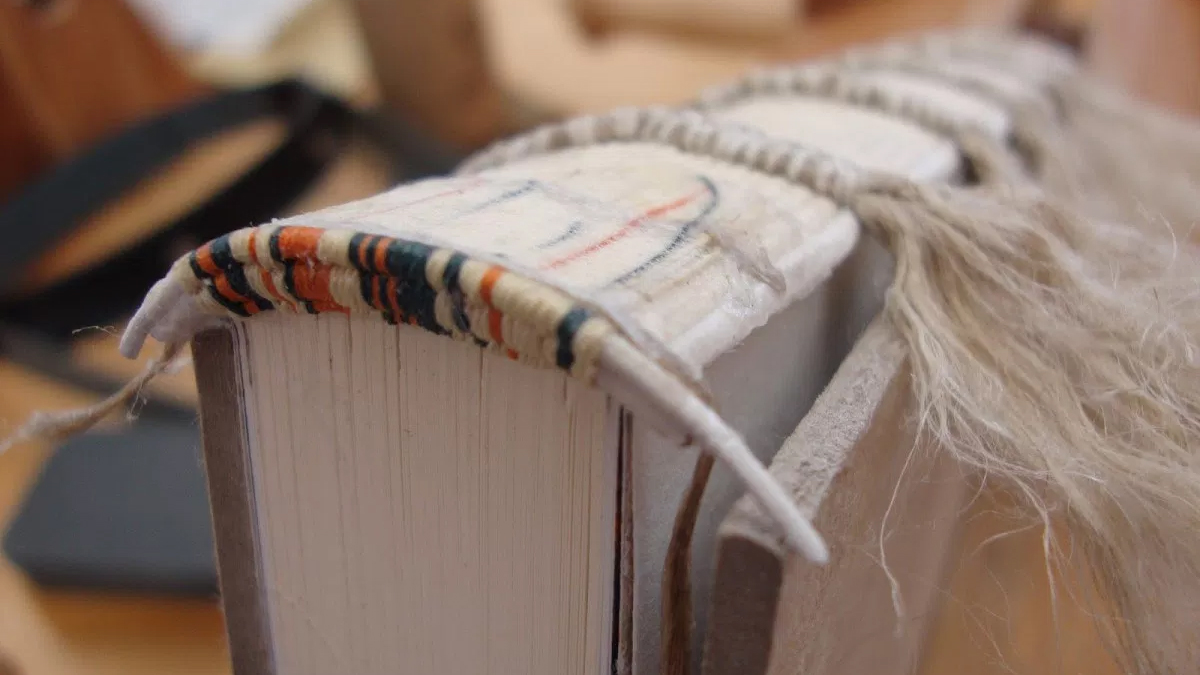12. Making Bookbinding Headbands Tutorial
Headbanding is the process of strengthening the head of a book. This is done by the sewing a cord onto the backbone behind the boards, which secures the signatures together more firmly. The result is a stronger binding construction, and even the backbone can be prevented from damage.
A good video introduction into creating and sewing headbands can be found in this YouTube playlist.
Well worth a watch before reading the rest of this tutorial. Enjoy!
Don't forget to subscribe to our YouTube channel to get access to HD videos of hundreds of Book Binding tutorials and reviews!
Piercing the Holes
For a headbanding, the holes should be pierced close to the centers of the folded signatures as shown in figure 208. Mark up the holes on the edge of the signatures; align a square card against the thickness on the folded edge and sketch a line that is about half an inch shorter than the book height. Leave this space at the heads of the signature as shown in figure 209. In case, the kettlestitches are at this same position, you can shift the line slightly towards the edge.
Take a cardboard that measures 2 inches in breadth and 4 inches in length, and place it inside the centre of the first signature. Push the card completely against the fold and pierce an awl through the signature right up to the edge of the cardboard as shown in figure 210. Using this same process, pierce every other signature. When you would be done, your signatures should resemble the image shown in figure 211.
Threading the Headband
Thread two needles with different color threads for a more attractive appearance. Tie their free ends together into a knot. Now start sewing the headband at signature numbered 1. Pry open the signature slightly by inserting a folding needle into its centre as shown in figure 212. Use the cardboard strips to locate the centre of the signature. Pass a thread through the pierced hole from the outside such that the needle is angled towards the top edge of the book as shown in figure 213. Pick up this thread from the center of the signature and tie the outside tail into a knot. This is illustrated in figure 214. Place a cord across the head of the book and pass the thread around it and out from the same hole through which you inserted it. Figure 215 depicts this step. Pull the thread tight so that the cord is flattened and secured in place over the signature as illustrated in figure 216. Tie the loose end with the first knot so that the stitch does not become loose. Now loop the thread two more times onto the cord and secure it by passing the thread beneath the cord, and into the loops as shown. This is shown in figure 217 and 218. Tie the end once more to the initial knot as shown in figure 219. Do not cut the tread and let it hang loose.
Now take the other thread, and wind it around the cord two times a shown in figure 220. The green loops should be completely lined up with the white loops so that no portion of the cord shows through them. Let this thread hang down.
Pick up the loose end of the first thread and pass it into the second hole as shown in figure 221. This time wind it around the cord three times as illustrated in figure 222, and once again, secure the loops by passing the thread beneath the cord and into the loops. Tie this thread at the same position where you passed it into the second signature as shown in figure 223. Pick up the loose strands of the colored thread and tie it to the thread you just worked with. Proceed in the same manner; keep winding the threads around the cord until it is completely covered as shown in figure 224. Tie both the loose ends at the other end into the knot to secure your work, and cut off the tails. Now view your work; if you were neat and followed the technique exactly like given, no part of the cord would be visible and the ends of the headband would be aligned with the hinges.
Just like with other binding techniques, headbanding requires sufficient practice. Until you do this, you would never be able to achieve a neat appearance.
[support-website]Additional Resources
- A fantastic Step by Step Colour Tutorial on Making Headbands by Nat @ From Hell to Breakfast
- A good video and description of sewing a headband by Bookbinder’s Chronicle
- Another good headband tutorial on V for Books (tumblr blog)
- Edge Guilding and Sewing a Faux Headband – Bookbinding.com
- A little post with some good info on Endbands @ Badger and Chirp
- A collection of headband photos on Pinterest
- Monastic Endband Tutorial with some good photos
Please Support us on Patreon!

Moreover, starting with the pledge level of $3, you will get a digitized vintage book about bookbinding, book history, or book arts each month from us!
These pledges help iBookBinding to continue its work and bring more information about bookbinding and book arts to you!














